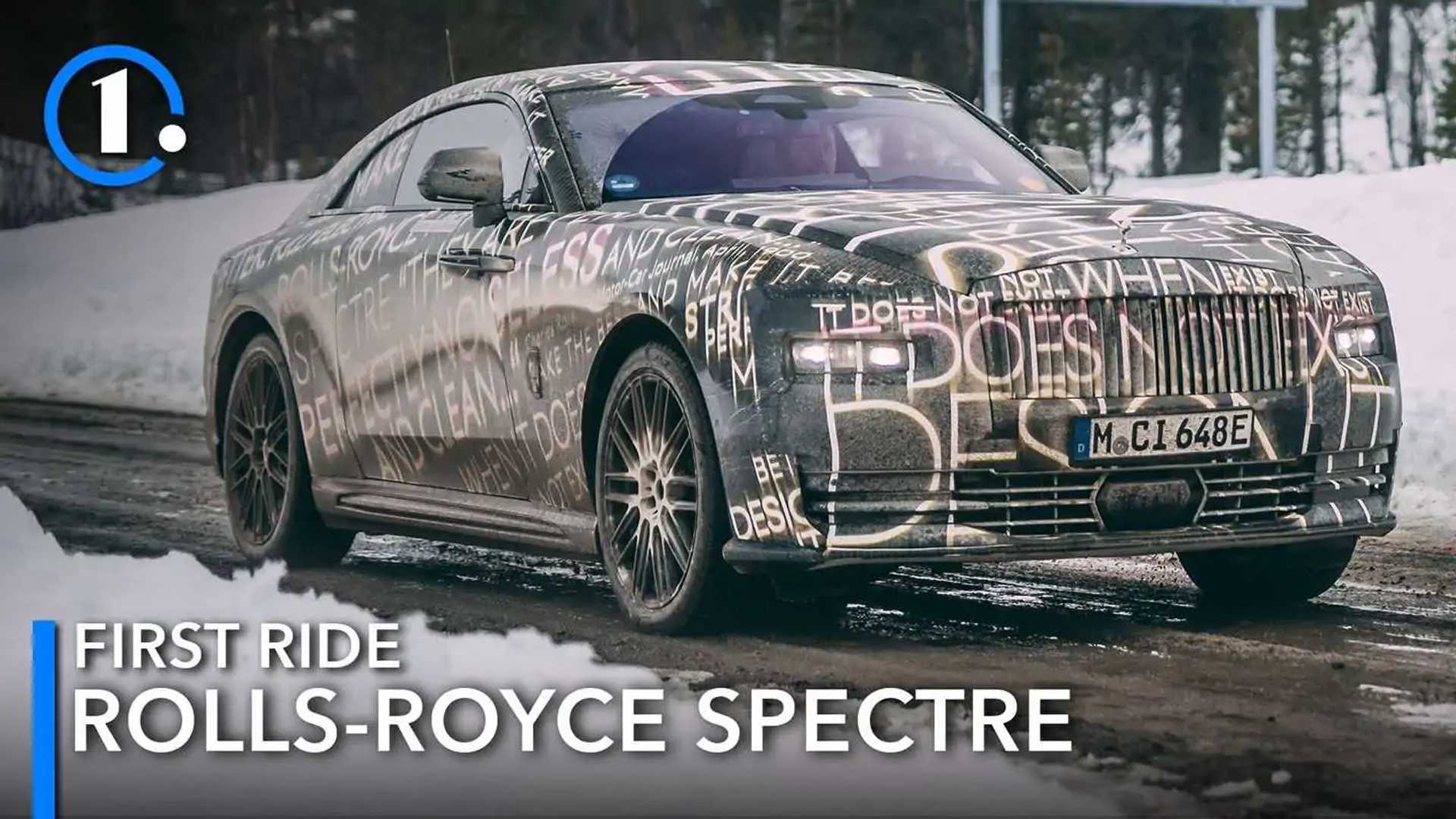
“This will be the worst Rolls-Royce you’ve ever experienced,” I’m warned, in no uncertain terms. The truth bomb has been dropped ahead of my ride (no driving today) in an early iteration of Spectre, the first fully electrified production car to hail from Goodwood.
Though the development vehicle is barely six weeks old and one of only six pre-production examples in existence, the sneak peek offers a glimpse at a hugely important model that will grace showrooms in late 2023. “We have to train this to become a Rolls-Royce,” the voice continues, “it’s only 25 percent there. It’s in kindergarten now, it needs to go finishing school.” Okay then: I’m fully braced for the least Rolls-Royce experience I’ll have in a Rolls-Royce. Bring it on.

For all the cautionary messaging, encountering Spectre in person is more intimidating than it is disappointing. The hulking body looks like a 125-percent scale model of Batman’s sinister supercoupé, wrapped in a conundrum of written quotes. Appropriately enough, it was inspired by the stately Phantom Coupé, the delightfully formal two-door that inspired the even more proper, $12.8 million Sweptail one-off commission. Beneath our tester’s camouflaged surfaces is a body that’s 85 percent complete, save some panel gaps which will be finessed for greater aerodynamic efficiency.
As it sits Spectre is the slipperiest Rolls-Royce ever, achieving an estimated drag coefficient of 0.26 in spite of its imposing body. Even the Spirit of Ecstasy has been resculpted to cut a sleeker swath across the leading edge of this 17-foot four-seater.

The prototype seems tall enough to be a crossover, with relatively small window apertures and elbow-high door sills. Though this particular example sits on 22-inch wheels due to its winter tires, the all-season configuration will feature 23s, the largest wheel diameters on a coupé since the 1926 Bugatti Royale; imagine superhero vibes, with a Great Gatsby twist.
Massive coach doors sweep backwards to reveal a lounge-like interior and a spacious rear cabin you wouldn’t think twice about seating your grandparents in. I can’t speak to the opulence of the details, as much of the interior is sheathed in secretive fabric covers and strapped with sensors, data logging equipment, and kill switches. But there’s still an air of grandeur in here, with a tall, aircraft-like dashboard and a faraway hood ornament that’s mostly hidden behind the bonnet’s curvature.

My driver eases the Spectre onto an icy road, and away we go in a (mostly) silent squeeze of acceleration. As promised, the body structure doesn’t feel as vault-like as a brand-new Roller, with door pins shaking on bumpy ground and faint road noise permeating the cabin. However, the prototype runs far quieter than many luxury cars, thanks in part to the 1,500-pound battery which provides a layer of sound deadening and insulation from the frozen road below.
Rolls won’t disclose battery formulations, cruising range, or kilowatt-hours. Also mum is how it will be calibrated for regeneration, though I’m assured it will not incorporate paddle shifters to adjust regen. And while those proprietary details will eventually trickle out (pun intended), there’s something oh-so Rolls-Royce about implying its specs are simply “adequate.” There’s also a whiff of insouciance regarding future-forward trends like electrification.

“We at Rolls-Royce are generally quite reticent to be first,” says communications boss Richard Carter. “We come to market when we’re ready… we take our time in perfecting our cars, and have no real interest in what any other manufacturer is doing out there.”
Okay then, on with the ride.
On a bumpy paved highway running through the Swedish countryside, the Roller’s ride feels busier and firmer than I’d expect, which I’m later told is a result of it being set to a baseline that is being adjusted as it gets refined. The system is adaptive and features an active anti-rollbar setup that’s an evolution of the one found on the Wraith. I do know that a total of four motors are driving all four wheels, and that cornering is aided by rear-wheel steering.
Though the 255-millimeter-section Pirelli winter tires look razor thin under such a hulking body, they do an impressive job of keeping the weighty coupe on the road. At one point, the driver dips the throttle at around 40 mph and the Spectre surges ahead in an effortless unfurling of power. The midrange torque is both unreal and easy, whooshing the massive four-seater ahead with propulsive ease.
We turn off onto a smaller single-track road, and the Spectre seems to handle these bigger bumps with more aplomb than it did the incremental ripples on the open highway. Again, work in progress. Out here against the sprawling scale of the Arctic Circle’s open spaces, this Roller seems exempt from society’s usual snap judgments about pretense, class, and snobbery. Rather than falling victim to the usual societal trappings, here it’s just a car— albeit an exceptionally large, imperious one aimed at a curiously specific demographic.

With the entire Rolls-Royce lineup converting to full EV by 2030, this marks a hugely important first step for the brand. It’s so momentous that the move has been dubbed “Rolls-Royce 3.0,” in honor of this new era of electrification. And while Spectre does indeed represent a massive departure from Goodwood’s V12-powered days of yore, the shift works far more seamlessly than the brand’s warnings might have led us to believe. Sure, the prototype faces a long road of development and refinement before it’s ready for paying customers late next year.
But because electrification ticks so many of the boxes Rolls-Royce has aimed to achieve with internal combustion for over a century, the shift feels positively normal and absolutely natural. The small niggly issues can’t hold a candle to its overarching ease with which it devours the road. The journey may have been over a century in the making, but the destination will have been well worth the trip.
!["[T]he First and Fifth Amendments Require ICE to Provide Information About the Whereabouts of a Detained Person"](https://images.inkl.com/s3/publisher/cover/212/reason-cover.png?w=600)






